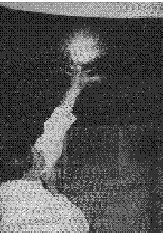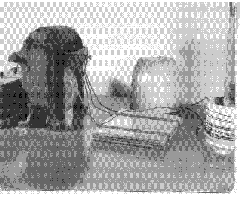
Tesla coils are simply radio frequency transformers with a high secondary to primary turns ratio. They are capable of some impressive (artificial lightning-type) displays but are relatively harmless. You won't get a shock from one but depending on the current capability, a RF burn could occur if arcs are drawn to bare skin.
Nikola Tesla invented the Tesla coil in an attempt to sent electricity without wires. Unfortunately, Maxwell had not only predicted that RF could be sent without wires but that the efficiency would be low. In other words, radio was possible but power transmission wasn't. Unfortunately, the experimentally oriented people like Tesla didn't spend any time studying the work of the theoreticians.
Tesla's most important invention was the ac motor, which made possible widespread power distribution and the use of electricity to power machinery. Edison's original power distribution system was based on dc, which severely limited the distance power could be distributed efficiently, due to resistive losses, since dc had to be distributed at the voltage it was used, since there was nothing like a dc transformer (with modern, solid state components, dc can be distributed at high voltages and then dropped to usable voltages for use so dc is making a comeback after almost 100 years).
Tesla coils are capable of generating very high voltages which can ionize the air and create impressive electrical displays. Because they operate at radio frequencies, the electricity travels along the surface of a conductor (including a human) and no shock is felt when a spark travels from the coil to a finger, for example.
The following pictures are from a book my dad had, published in 1921 entitled "Electricity at High Frequencies and Pressures" by Henry Transtrom. It not only contained a wealth of info on how to build Tesla Coils but a very succinct presentation of Electrical Engineering Theory. I wish that I had studied it better in the 50's rather than jumping directly to the "how-to" stuff.
This shows a spark discharge from the hand of a person standing on a chair (so the sparks wouldn't jump directly to the ground) with the secondary of the coil shown in the next picture connected to his foot.

The next picture shows a large corona discharge. Note that the person's nose is attracting it. If you like ozone, breathe deeply.

This is a large Tesla coil with the insulators at the top spaced 5 feet apart.

A five foot long spark discharge from the coil pictured above.

On a more modest note, shown below is a Tesla coil I built with my dad's help in the early 50's. A reactance coil is at the far left. Next to it is a step-up transformer powered from good old 117 vac through the reactance coil. A capacitor made from sheets of tinfoil (yes, tinfoil) sandwiched between sheets of plate glass. Behind it, under the flower pot, is a spark gap. It was covered because otherwise, the light from it would make the Tesla coil discharges harder to see. At the right is the Tesla coil. The primary was wound on an oatmeal container. P. S.- I still have the reactance coil and step-up transformer.

At the left is a corona discharge from a hoop of wire about 6 inches in diameter. The discharge from the foil into the air is shown on the right.

Return to Table of Contents